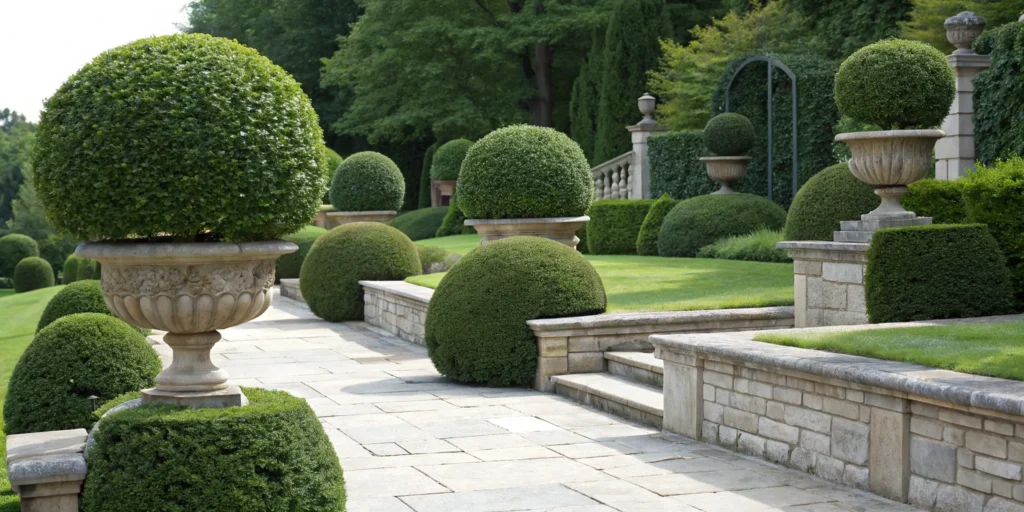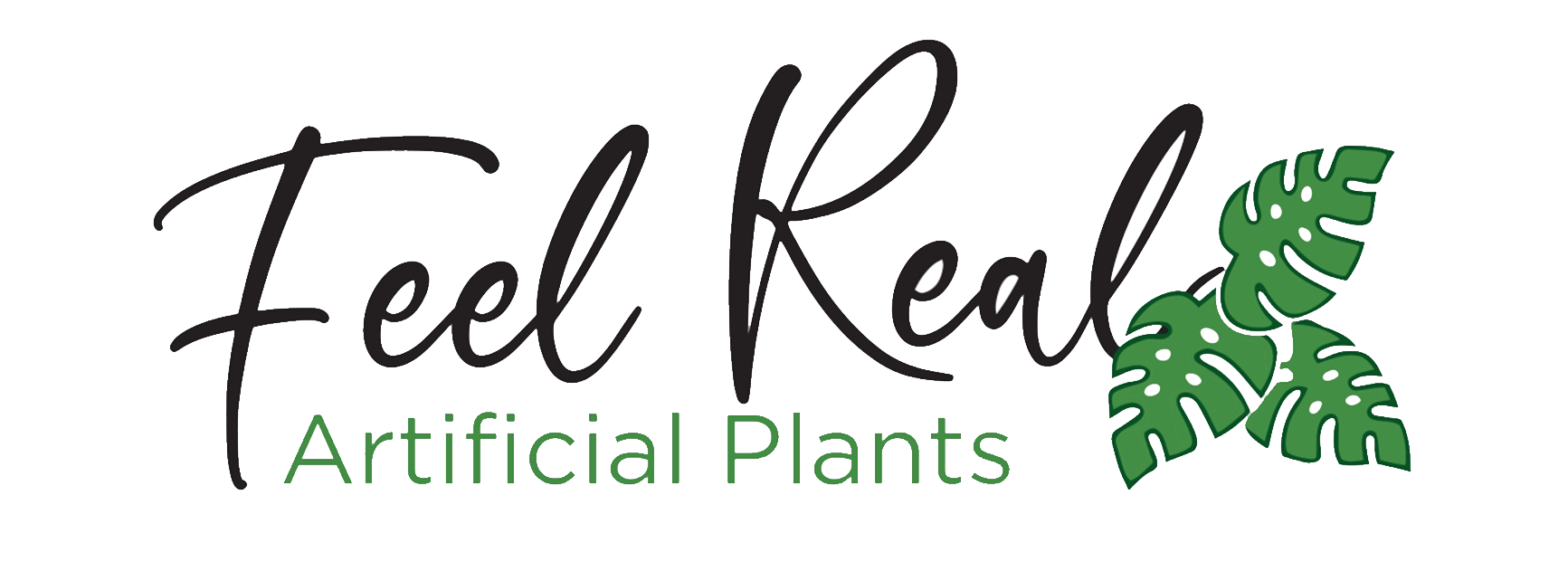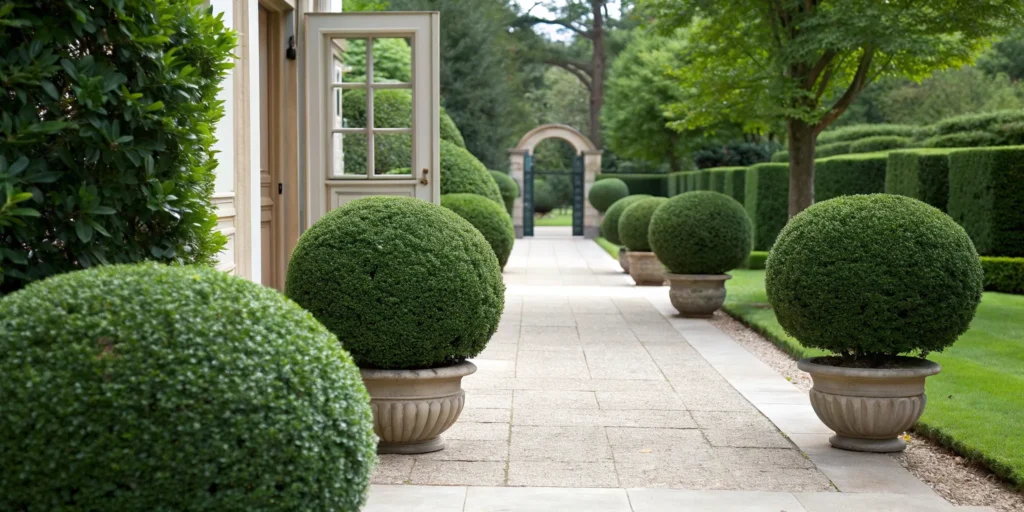Have you ever seen those perfectly round boxwood balls flanking entryways? Have you ever seen spiraling trees in outdoor pots? These are all examples of the art of topiary in action. From ancient Roman villas to modern urban balconies, the practice has shaped the way we decorate our outdoor spaces.
They blend nature with human creativity. Now, easy-to-maintain artificial plants can do the same, alongside real ones. Let’s take a closer look at what makes topiary unique and its origins. What trends are expected to be popular in 2025.
What Exactly Is Topiary?
Topiary is the horticultural practice. It trains and trims plants into specific ornamental shapes. These plants are typically shrubs and trees. The term comes from the Latin word “topiarius”. It means ornamental gardener. You’ll recognize topiary by its distinctive geometric forms, animal figures, or architectural designs. These designs can help to transform ordinary greenery into living sculptures.
Traditional topiary uses plants like boxwood, yew, and privet. Because their dense foliage and small leaves allow gardeners to create sharp edges. When you trim these plants regularly, they develop compact growth that holds crisp shapes. The most common topiary forms include round balls, spirals, cones, pyramids, and even complex animal figures. If you want to define your landscaping, you can display these sculptured plants in outdoor planters, garden beds, or as standalone statement pieces.
Today’s topiary world includes both real and artificial options. All of us know, real topiary requires patience. You’ll spend months or years training branches and maintaining shapes through regular trimming. Artificial topiary is made of plastic or synthetic materials. These materials create an instantly realistic effect, complementing the look of real plants. Many homeowners and businesses choose fake topiary. Because it requires minimal maintenance to create a flawless look. They’re ideal for both indoor and outdoor spaces where real plants struggle.

The Ancient Origins of Topiary
Topiary’s story began in ancient Rome over 2,000 years ago. It is introduced by Gaius Matius Calvinus, a friend of Julius Caesar. He is famous for filling his Tuscan villa with elaborate topiaries. The shapes are like animals, obelisks, even carved inscriptions. Wealthy Romans saw this and copied it. Soon, their gardens were filled with trimmed hedges and shrubs that looked like statues. Back then, topiary was a status symbol: only the elite could afford the time and gardeners needed to keep these “living sculptures” neat.
When the Roman Empire fell, topiary faded into obscurity for nearly 900 years. It made a comeback in the 16th century during the Renaissance. Italy, France, and England’s formal gardens embraced it. Think the Gardens of Versailles, the designer André Le Nôtre used hedge topiaries to create symmetry and order, matching the era’s love of “perfect beauty”. By the 19th century, it crossed the Atlantic. Inspired by English gardens, American colonists added topiaries to Colonial Revival yards. Like the famous topiary maze at Virginia’s Colonial Williamsburg.
But topiary didn’t go mainstream until the 20th century. Thanks to Walt Disney, Disneyland’s parks used steel wire frames to grow shrubs into cartoon characters (think Mickey Mouse or Donald Duck). Disney even trademarked these designs and made portable topiaries. Suddenly, topiary wasn’t just for fancy gardens anymore. It became fun, accessible, and a staple of family-friendly spaces.

What Are the Most Famous Topiary Styles&Shapes?
Topiary comes in endless shapes. Each style has a different purpose in your landscape design. Whether it’s a simple sphere or a complex animal shape, they can add whimsy. Understanding these classic forms will help you choose the right topiary style for your space.
Geometric Topiary: Spheres, Cones & Pyramids
Geometric shapes are the classic topiary style. It is clean, versatile, and easy to recognize. The key here is symmetry: every edge is sharp, every angle precise.
Spheres: Small, round topiaries, like buxus, are fit perfectly in pots on porches or beside front doors. They’re a favorite for adding a cozy, balanced look to outdoor spaces.
Cones & Pyramids: Taller, more dramatic shapes. You’ll see these lining driveways or flanking garden gates. They feel grand but not over-the-top.
These styles work with both real and artificial topiaries. For example, a faux boxwood cone can stay bright green all winter, while a real one needs regular trimming to keep its pointy shape.
Figurative Topiary: Animals & Characters
Figurative topiary is where creativity shines. It turns shrubs into living statues of animals, people, or even mythical creatures. The Romans pioneered this style, sculpting plants into lions, bears, and hunting scenes. Today, you’ll find everything from simple rabbit shapes to elaborate giraffe figures that can reach 8-10 feet tall. These statement pieces become conversation starters and define your landscape’s personality.
Creating animal topiaries from real plants demands exceptional skill and patience. Professional topiarists use wire frames as guides. They usually need to train branches through the structure over several years. Popular animal shapes are dogs, cats, birds, and deer. Because their silhouettes translate well into plant form.
Artificial animal topiaries have made this elaborate style accessible to everyone. You can purchase realistic-looking deer, rabbits, or even elephants made from plastic greenery. As they mimic real foliage. These faux creatures work exceptionally well for seasonal displays, commercial properties. They are also fit for the homeowners who want impressive sculptural elements without years of plant training. Real topiary animals require weekly trimming during growing season, while false topiary maintains its shape indefinitely with just occasional cleaning.

Spiral & Ball Topiaries
These two styles are close cousins. Both focus on rounded or twisting forms, but with unique vibes.
Spiral topiaries feature plants trained into corkscrew forms with curving ribbon, while multi-ball topiaries stack perfectly round spheres along a single trunk. These distinctive shapes became popular in European formal gardens during the 17th century. The spiral design particularly catches your eye. Because its three-dimensional twist looks impressive from every angle. It is perfect for entryway planters or focal points in your landscape.
For real plants, like boxwood or cypress, if you want to create them into a spiral topiary, it takes 3-5 years of careful training. You start with a young tree, then gradually trim a spiraling channel around the trunk. At the same time, you need to encourage the remaining foliage to grow dense. The result is a sculptural green ribbon that rises upward. Multi-ball topiaries, sometimes called “lollipop trees,” feature 2-4 spherical balls stacked on one stem. These work beautifully in pots, because they provide substantial visual presence with a compact footprint.
Faux spiral and ball topiaries deliver instant sophistication without the time investment. You’ll find artificial topiaries in various heights, typically ranging from 3 to 6 feet. They are perfect for framing doorways or anchoring corner spaces. The plastic or synthetic materials hold their spiral shape permanently. So no seasonal growth will distort the pattern. Many designers choose these for commercial spaces, apartment balconies, or areas with difficult growing conditions.

Architectural Topiary: Arches & Hedges
Architectural topiary is all about building with plants. It turns greenery into functional, structure-like shapes that define spaces. These large-scale structures include hedge walls, arches, tunnels, and window-like openings. It can help to establish boundaries, frame views, or guide visitors through your landscape.
Arches: Topiary arches are made by training shrubs (often boxwood or ivy) over a metal frame. They’re stunning entryways to gardens. If you walk under one, you will feel like you’re stepping into a secret green room.
Hedges: Tall, thick topiary hedges that act as walls. If you want to divide a backyard into a dining area and a play area, you can use it. If you want to hide unsightly spots, you can also use it. The famous hedges at Versailles are a classic example. They’re so precise, and they look like they’re cut with a ruler.
Now, modern landscaping increasingly uses artificial hedge panels and faux topiary walls for instant results. These imitation panels install directly onto fences or frames. It can give you the look of mature hedge topiary immediately. You know, real hedges requiring 5-7 years to reach full height. False hedge topiaries can only transform your space in hours while needing zero maintenance.
Topiary Today: 2025 Trends & Innovations
In 2025,, the topiary market has expanded beyond traditional formal gardens into urban spaces, commercial properties, and residential landscapes. People want sculptural greenery without intensive upkeep. Meanwhile, the artificial topiary segment has grown by approximately 35% since 2023. It reflects increasing demand for year-round green installations. And the installation should perform consistently in challenging environments. Whether you have a tiny apartment balcony or a sprawling backyard. Here’s what’s hot right now:
Architectural Uses of Topiary in Landscaping
In 2025, progressive landscape designers treat topiary not just as decoration but as structural elements. These elements can define how you experience outdoor spaces. It can help to organize large properties into intimate zones. And sculpted trees can create natural canopies over seating areas.
Commercial properties increasingly rely on topiary for brand identity and wayfinding. Hotels use matching cone-shaped topiaries to mark entrances. Shopping centers create topiary landmarks that help visitors navigate. Real estate developers incorporate topiary into new residential communities, because these sculptural elements increase property values. Generally, compared with comparable properties without distinctive greenery, homes with professional topiary in landscaping typically sell 8-12% faster.
Contemporary architectural topiary combines traditional forms with unexpected applications. You might see geometric topiary balls suspended in mid-air using clear supports. It can help to create floating greenery effects. Spiral topiaries frame outdoor staircases. Whether it can draw your eyes upward along vertical spaces. Instead of traditional lawns, residential designers use low boxwood hedges trimmed into intricate knot patterns as living ground cover.

Artificial Topiary Trends for Modern Spaces
Faux topiary has become the preferred solution for 2025’s demanding environments. No matter they are harsh climate regions or the indoor commercial spaces where real plants can’t survive. The artificial greenery industry has revolutionized plastic plant manufacturing. Now they are producing topiary with UV-resistant materials that maintain color for 5-10 years outdoors. Besides, their realistic textures are closely mimic natural buxus and other common topiary plants. You can now purchase fake topiary that looks convincingly real from various types. Here are the top trends:
Mini Faux Topiaries: Small, portable ball or cone topiaries that fit on windowsills, desks, or tiny patio tables. They’re perfect for renters who can’t plant real shrubs.
Weather-Resistant Faux: Outdoor faux topiaries made from durable plastic that can handle rain, snow, and sun without fading. No more bringing plants inside for winter!
Mixed Materials: Faux topiaries paired with modern planters. You can pair a concrete pot with a faux spiral boxwood. You can also pair a metal hanging basket with a small ball topiary. It’s a sleek and contemporary look that fits 2025’s minimalist vibe.
One big reason for the trend? Busy lifestyles. People want the beauty of greenery without the work. Faux topiary is always the best solution.

The Modern Solution: Why Choose Faux Topiary?
Let’s be real: real topiary is lovely, but it’s a commitment. Faux topiary solves all the pain points. So more and more people are making the switch. Here’s why:
Year-Round Beauty Without the Constant Upkeep
Real topiary needs regular care: watering, pruning, fertilizing, and protecting from pests. If you forget to water a buxus topiary, its leaves turn brown. If you don’t prune it, your carefully maintained shapes become shaggy and lose definition. Winter often brings additional challenges, as snow and ice damage branches or cause bare patches. If you have 6-8 trimmed balls, then just for the care of the trimmed balls alone, you will need to invest 15-25 hours per month.
Faux topiary? No upkeep. It stays bright green in summer heat. It doesn’t wilt in winter snow, and never needs a trim. Whether it’s a fake ball topiary on your porch or a faux hedge in your office, it looks perfect 365 days a year. Artificial topiary needs only occasional hosing off to remove dust and debris. It needs perhaps 15 minutes every 2-3 months. This is a game-changer for busy people, frequent travelers, or anyone who doesn’t have a green thumb. You get the lush garden look without the stress.
Perfect Shapes and Lasting Durability for Any Space
High-quality faux topiary maintains mathematically precise shapes. You know, the real plants can never achieve. The faux one can provide architectural consistency that enhances formal design schemes. Even expert topiarists struggle to create perfectly symmetrical spheres from living plants. After all, natural growth variations always produce slight irregularities.
Durability advantages extend beyond shape retention. Premium artificial topiaries constructed from UV-resistant plastic maintain their original green color for 5-10 years in full sun exposure. And the synthetic materials can resist wind damage, storm breakage, and animal interference. So it can go places real plants can’t. However, lower-quality real plants may brown or develop bare patches after harsh winters or summer stress.

Topiary is a timeless art form. It adds structure and elegance to any space, from ancient Roman villas to modern patios. Today, you can achieve this classic beauty without the constant caring.
Ready to elevate your project with stunning, realistic decorative topiary?
FeelReal is a leading manufacturer of premium, UV-resistant faux topiaries. We craft stunningly realistic boxwood balls, spirals, cones, and custom hedge panels for customers worldwide.
Browse our extensive collection and contact our team today. We are ready to discuss your wholesale and commercial project needs. Let’s bring your vision to life.
FAQs About the History of Topiary
1: What is the symbolism of topiary?
Topiary symbolizes humanity’s ability to control and refine nature. It represents order, sophistication, and wealth throughout history. In Roman times, elaborate topiaries demonstrated social status. Only wealthy landowners could afford the staff to maintain complex plant sculptures. Renaissance gardens used topiary to express mathematical precision and philosophical ideals about perfection. Today, it’s more about style. Geometric shapes, like spheres, represent balance and order. Figurative shapes, like animals, symbolize whimsy and creativity. It’s a way to show you care about your space, whether it’s a tiny balcony or a big backyard.
2: What defines a topiary garden?
A topiary garden features multiple sculptured plants as its primary design element. It uses shaped trees and shrubs to create formal structure and visual interest. The typical gardens focus on colorful flowers or naturalistic plantings, while topiary gardens emphasize geometric precision and sculptural forms. You’ll find topiary gardens organized around symmetry. These gardens often have a cohesive style. The Ladew Topiary Gardens in Maryland are filled with animal-shaped topiaries. The gardens at Château de Villandry in France are known for geometric buxus topiaries.
3: What’s the difference between topiary & bonsai?
The key difference is size, technique, and goal:
Topiary: Uses full-size real or faux shrubs or trees and focuses on shaping the outer foliage into decorative forms, like spheres, animals, arches. It’s usually outdoors and meant to be seen from a distance.
Bonsai: Uses tiny, dwarf trees grown in small pots. The goal is to mimic the look of a full-size tree in a miniature form. These trees are generally with twisted trunks and tiny leaves. It’s often indoors and meant to be viewed up close, like a small work of art.



